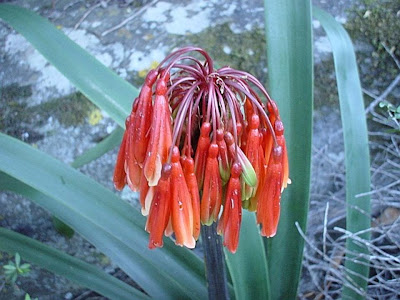It is very interesting to note that the early plant hunters were collecting plants as early as the late 1600's along the West Coast of South Africa and Namakwaland, but missed the evading mirabilis. Instead its closest relative, clivia nobilis, was the first clivia discovered by plant hunters and collectors and described in 1828. Clivia miniata followed in 1854.
However the indigenous people was always aware of this beautiful desert beauty and picked the beautiful flowers to show the first white settlers who moved into these areas. Although the first white people tried to plant them in their gardens and nearby beach houses, they were unsuccessful most of the time. Clivia mirabilis was rediscovered in the late 1990's in the Oorlogskloof Nature Reserve and named for the first time. I have studied these plants for a couple of years in the wild and the below photo collection is part of the presentation I gave at the 2006 World Clivia Conference. A lot of scientific research has been done in the meantime and it is interesting to see how I picked up the similarities between nobilis and mirabilis so many years ago. That time it was thought that mirabilis was the ancestor of all clivia, but research has shown that it is merely a close relative of nobilis. I hope you can learn a lot from looking at these photos and my observations that time. These photos were taken over a period of a couple of years during the different months of the year to give you a feeling how mirabilis is struggling to survive in the wild. During the years before 2006, Namakwaland was going through a dry period and you can see how even the trees that was the last protection for mirabilis against the sun was starting to die. Luckily mirabilis is as tough as agapanthus and aloe and survived the hot dry cycle to recover fully during the wet period that followed after 2007.
From time to time I sell clivia mirabilis seed, so feel free to e-mail me around beginning February each year as the seed ripens around end February to beginning March. During this time of the year temperatures can reach up to 50 deg C in the mountains where they grow and harvesting seed is by all means not an easy process as you have to be on the look out for dangerous snakes all the time. Send me an e-mail at heingrebe@ymail.com to put your name on the seed list. For clivia mirabilis seedlings or hybrid clivia mirabilis seedlings you can also send me a mail and then I can tell you what is available. Click on the photos below to expand it.
However the indigenous people was always aware of this beautiful desert beauty and picked the beautiful flowers to show the first white settlers who moved into these areas. Although the first white people tried to plant them in their gardens and nearby beach houses, they were unsuccessful most of the time. Clivia mirabilis was rediscovered in the late 1990's in the Oorlogskloof Nature Reserve and named for the first time. I have studied these plants for a couple of years in the wild and the below photo collection is part of the presentation I gave at the 2006 World Clivia Conference. A lot of scientific research has been done in the meantime and it is interesting to see how I picked up the similarities between nobilis and mirabilis so many years ago. That time it was thought that mirabilis was the ancestor of all clivia, but research has shown that it is merely a close relative of nobilis. I hope you can learn a lot from looking at these photos and my observations that time. These photos were taken over a period of a couple of years during the different months of the year to give you a feeling how mirabilis is struggling to survive in the wild. During the years before 2006, Namakwaland was going through a dry period and you can see how even the trees that was the last protection for mirabilis against the sun was starting to die. Luckily mirabilis is as tough as agapanthus and aloe and survived the hot dry cycle to recover fully during the wet period that followed after 2007.
From time to time I sell clivia mirabilis seed, so feel free to e-mail me around beginning February each year as the seed ripens around end February to beginning March. During this time of the year temperatures can reach up to 50 deg C in the mountains where they grow and harvesting seed is by all means not an easy process as you have to be on the look out for dangerous snakes all the time. Send me an e-mail at heingrebe@ymail.com to put your name on the seed list. For clivia mirabilis seedlings or hybrid clivia mirabilis seedlings you can also send me a mail and then I can tell you what is available. Click on the photos below to expand it.
The last photo shows the owner, Mias Vollgraaff, and his youngest son Jonathan in a small 4 wheel drive vehicle that is used to visit the plants. It is small enough to go underneath the trees and can move easily over rough, steep and uneven terrain. The farm is a couple of thousand ha in size. Most of the veld is still in pristene original condition with a wide range of indigenous plants growing there ranging from succulent and stone plants to aloes & trees. A wide range of indigenous flower bulbs as well as rare orchids can be seen in flower each year if the rain comes in time.





































































































No comments:
Post a Comment